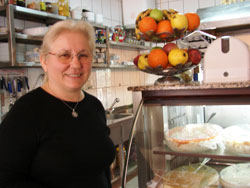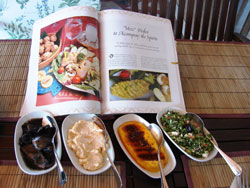What’s cooking in … Turkey
This item appears on page 56 of the December 2010 issue.
by Sandra Scott
My husband, John, and I spent March 2010 traveling along the coast of Turkey enjoying the local cuisine, which included plenty of fresh fish and vegetables. We inquired about cooking classes at our hotels. The answer was always the same: “No, but we are thinking about it.”
In Bodrum we posed the same question at the tourist office. They suggested we check with the restaurant Komodor Meze Evi (Umurça mah, Dervis¸ Görgün Cad. No. 23/C, Bodrum, Turkey; phone [0252] 313 75 55), where they were sure the owners would show us how to prepare some local favorites.
Kaan, the front-office manager of Divan Bodrum Palmira, called the restaurant, explained what we wanted to do and arranged a cooking experience for 2:30 the next day. Manolya, the restaurant owner, explained, “We cater to the local clientele, and they often pitch in to help. We will let anyone help and watch preparations, but it has to be at a time we pick because we are too busy during mealtimes.”
Ibraham, the restaurant’s executive chef, showed John and me how to make several mezes, Turkish appetizers made up of a selection of small cold and hot dishes. The chosen dishes are placed in the center of the table to be shared, creating a sociable dining environment. Even though mezes are considered appetizers, we found that sharing several makes a great meal.
One of the dishes we learned to make was Irmik Helvası. Manolya explained, “This is a dish we make for religious holidays and take to neighbors when there is a death or sickness in the family. The ingredients are available in everyone’s kitchen.”
We also helped to prepare cuttlefish in ink, a favorite of the local fishermen, and, my personal favorite, Havuç Tarator, made from carrots.
Most meze dishes cost about $3 each, but the fish mezes are usually a little bit more. Our lunch with cooking instructions cost $12 for the two of us.
2 cups semolina
1 tsp vanilla
¼ cup finely chopped walnuts
¹⁄8 cup sesame seeds
Peel from one orange
4 cups water
1⅓ cups sugar
¾ cup margarine
Add the orange peel to the water and boil for 30 minutes. Remove from heat, discard orange peel, then add sugar. Stir until dissolved. Set aside. In a deep pan, melt margarine. Add semolina. Stir until it becomes light brown. Add sugar water. Stir and simmer 10 minutes. Add vanilla. Stir. Serve topped with walnuts and sesame seeds.
⅓ cup olive oil
2-4 cloves garlic, sliced
juice of one lemon
2 lbs cuttlefish with ink cut into one-inch pieces. (Ask the provider to include the ink. It is often discarded.)
water, as needed
1 tsp sugar
1 tsp salt
¼ cup Turkish-style yogurt. (It can be made by straining yogurt through cheesecloth, draining off as much water as possible.)
4 oz chopped walnuts
1 tbsp red chili flakes (dill and parsley can be substituted, if to one’s taste)
6-7 carrots, peeled and grated
2-3 tbsp olive oil
3-5 cloves of chopped garlic
salt to taste


